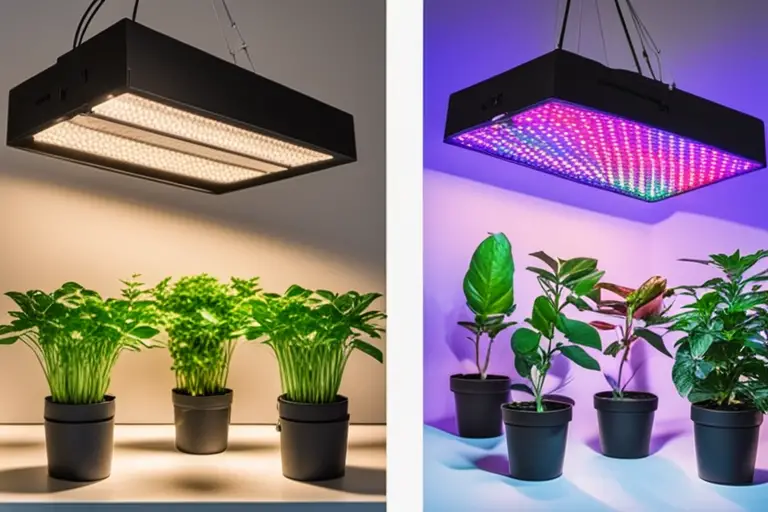What You’ll Learn
By reading this article, you will learn:
– How Much Do LED Grow Lights Cost to Run?
– The factors and calculations involved in determining the cost of running LED grow lights.
– The comparison of LED grow lights to other lighting options in terms of energy efficiency and cost-effectiveness.
– Tips for reducing energy consumption and costs when using LED grow lights.
1. LED grow lights’ energy consumption and cost calculation.
2. Comparison of LED grow lights to other lighting options for indoor gardening.
3. Tips for reducing energy consumption and costs when using LED grow lights.
Indoor gardening has become increasingly popular among enthusiasts and professionals alike. Whether you’re growing herbs, vegetables, or medicinal plants, providing the right lighting conditions is crucial for their growth and development. LED grow lights have emerged as a game-changer in this field, offering numerous benefits over traditional lighting options.
LED grow light are specially designed to emit the right spectrum of light for optimal plant growth. Unlike traditional grow lights, such as fluorescent and HID lights, LED grow lamps are highly energy-efficient and produce less heat. This makes them ideal for indoor gardening, where temperature control is essential.
Factors Affecting the Cost of Running LED Grow Lights
When determining the cost of running LED grow lights, several factors come into play. Understanding these factors can help you make informed decisions and optimize your lighting setup for cost-effectiveness.
Wattage of LED Grow Lights
The wattage of LED grow light is a significant factor in energy consumption and the cost of running them. LED grow lights come in various wattages, ranging from as low as 25 watts to as high as 1000 watts or more. Higher wattage lights generally provide more intense light output, but they also consume more electricity.
Hours of Operation per Day
The number of hours your LED grow lights are operational each day directly affects energy consumption and the cost of running them. The longer your lights are on, the more energy they will consume. Consider the specific light requirements of your plants and adjust the hours of operation accordingly.
Electricity Rates in Your Area
Electricity rates vary from one location to another, and this difference can significantly impact the cost of running LED grow lights. Check your electricity bill or contact your utility provider to find out the cost per kilowatt-hour (kWh) in your area. This information will be crucial in estimating your electricity costs accurately.
Size of the Growing Area
The size of your growing area also plays a role in the cost of running LED grow lights. Larger areas require more lights to ensure adequate coverage, which means higher energy consumption. Consider the size of your space and the lighting requirements of your plants when calculating energy consumption and costs.
Calculating Energy Consumption of LED Grow Lights
To accurately estimate the energy consumption of your LED grow lights, follow a step-by-step calculation process. This will help you understand the precise amount of electricity your lights consume and the subsequent costs involved.
Step-by-Step Guide to Calculating Energy Consumption of LED Grow Lights
- Determine the wattage of your LED grow lights. This information can usually be found on the product packaging or in the product specifications.
- Calculate the total wattage by multiplying the wattage of a single light by the number of lights you have.
- Determine the hours of operation per day for your LED grow lights.
- Multiply the total wattage by the hours of operation to get the total watt-hours (Wh) per day.
- Convert the total watt-hours to kilowatt-hours (kWh) by dividing the watt-hours by 1000.
Estimating Electricity Costs
Once you have calculated the energy consumption of your LED grow lights, estimating the electricity costs becomes a straightforward task. You’ll need to know the cost per kilowatt-hour (kWh) in your area, which can be obtained from your electricity bill or by contacting your utility provider.
Finding the Cost per Kilowatt-Hour (kWh) from Your Electricity Bill
To find the cost per kilowatt-hour (kWh) from your electricity bill, locate the section that provides the details of your electricity usage. Look for the amount charged per kWh and note it down. If you can’t find this information on your bill, reach out to your utility provider for clarification.
Multiplying the Energy Consumption by the Cost per kWh
Using the example from earlier, where the energy consumption was calculated to be 6 kilowatt-hours (kWh) per day, let’s assume the cost per kWh in your area is $0.12.
Multiply the energy consumption (6 kWh) by the cost per kWh ($0.12) to get the estimated daily cost of running your LED grow lights: 6 kWh x $0.12 = $0.72 per day.
By multiplying the daily cost by the number of days in a month or year, you can estimate the monthly or annual electricity costs of running your LED grow lights.

Comparing LED Grow Lights to Other Lighting Options
LED grow lights hold a clear advantage over other traditional lighting options, such as fluorescent and HID lights, when it comes to energy efficiency.
Learn more about Why LED Grow Lights Are Better Than Other Types of Lighting for Indoor Gardening
Energy Efficiency Comparison with Fluorescent and HID Lights
LED grow lights are known for their exceptional energy efficiency. They produce more light per watt compared to fluorescent and HID lights, which means they consume less electricity for the same level of light output. This translates into lower energy costs and reduced environmental impact.
Long-Term Cost-Effectiveness of LED Grow Lights
While the initial investment in LED grow lights may be higher compared to other lighting options, their long-term cost-effectiveness is undeniable. LED grow lights have a longer lifespan, typically lasting for tens of thousands of hours, whereas fluorescent and HID lights may require frequent bulb replacements. Additionally, LED lights produce less heat, reducing the need for additional cooling equipment and further saving on energy costs.
Additional Cost Considerations
When estimating the cost of running LED grow lights, it’s important to consider additional factors that can contribute to the overall expenses.
Initial Investment in Purchasing LED Grow Lights
LED grow lights may have a higher upfront cost compared to other lighting options. However, the long lifespan and energy efficiency of LED lights make them a worthwhile investment in the long run. Consider the quality and features of the lights before making a purchase to ensure you’re getting the best value for your money.
Maintenance Costs
LED grow lights generally require minimal maintenance compared to other lighting options. They don’t have bulbs that need frequent replacement, reducing ongoing maintenance costs. However, it’s important to keep the lights clean and free from dust or debris to maintain optimal performance.
Additional Equipment for Proper Installation
Proper installation of LED grow lights may require additional equipment, such as hanging kits, light meters, and timers. While these additional expenses can add up, they are crucial for maximizing the effectiveness of your lighting setup and ensuring optimal plant growth.
Tips for Reducing Energy Consumption and Costs
To further optimize energy consumption and reduce costs when using LED grow lights, consider implementing the following tips:
Optimizing Light Intensity
Adjust the light intensity of your LED grow lights based on the specific needs of your plants. Providing the right amount of light without overdoing it can help conserve energy while still promoting healthy growth.
Using Timers or Dimmers
Utilize timers or dimmers to automate the on/off cycles of your LED grow lights. This ensures that they are only operational when necessary, preventing unnecessary energy consumption during non-essential periods.
Implementing Proper Ventilation
Proper ventilation helps regulate temperature and humidity levels in your growing area, reducing the need for additional cooling equipment. This, in turn, helps save energy and lower overall costs.
Case Studies and Real-World Examples
Numerous individuals and businesses have experienced significant benefits and cost savings by using LED grow lights in their indoor gardening setups. Real-world examples and case studies are valuable resources for understanding the practical applications and potential cost savings associated with LED grow lights.
Success Stories of Individuals/Businesses Using LED Grow Lights
Share success stories of individuals or businesses that have achieved remarkable results using LED grow lights. Highlight the specific benefits they experienced, such as increased yield, improved plant quality, and reduced energy costs.
Reduction in Energy Costs and Savings Achieved
Provide concrete examples of the energy cost reductions achieved by individuals or businesses after switching to LED grow lights. These examples will further emphasize the long-term cost-effectiveness of LED lighting solutions.
Real-Life Cost Savings with LED Grow Lights
Growing up in a small town in California, Flora always had a passion for gardening. When she decided to start her own indoor garden, she was initially concerned about the cost of running grow lights. After doing some research, she opted for LED grow lights due to their energy efficiency.
Flora’s Experience
Flora calculated the energy consumption of her LED grow lights, which were 200 watts, and estimated that they were on for 12 hours a day. With an electricity rate of $0.12 per kWh, she found that the monthly cost to run her LED grow lights was only $17.28. This was significantly lower than she had anticipated, and she was pleasantly surprised by the cost savings.
By sharing her experience, Flora hopes to inspire others to consider the long-term cost-effectiveness of LED grow lights for their indoor gardens. She believes that the initial investment is worth it, considering the energy and cost savings in the long run.
Conclusion
LED grow lights offer numerous benefits over traditional lighting options for indoor gardening. While the cost of running LED grow lights depends on factors such as wattage, hours of operation, electricity rates, and the size of the growing area, they prove to be a cost-effective choice in the long run.
LED grow lights are highly energy-efficient, resulting in lower energy consumption and reduced electricity costs. Their long lifespan and minimal maintenance requirements further contribute to their cost-effectiveness. By optimizing light intensity, using timers or dimmers, and implementing proper ventilation, you can further reduce energy consumption and costs.
So, if you’re considering investing in LED grow lights for your indoor garden, rest assured that they offer a cost-effective and environmentally-friendly lighting solution.



Leave a Reply